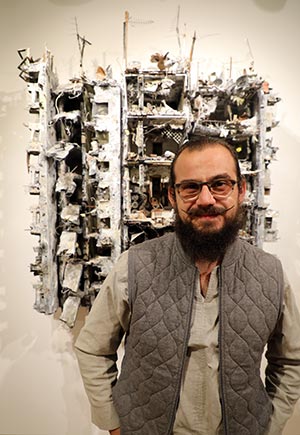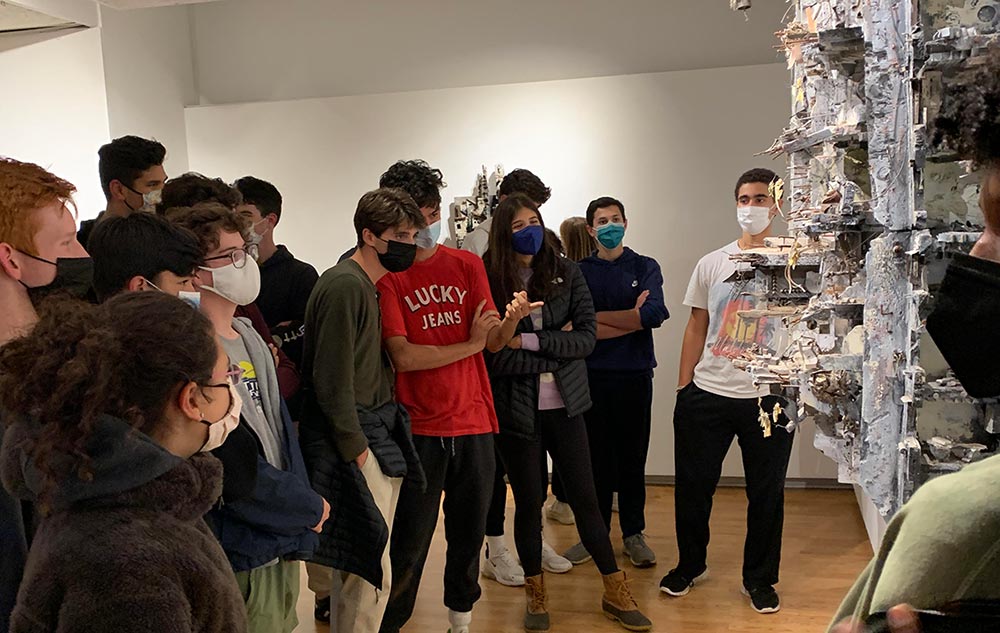 “Art is so damn powerful,” Syrian American artist and architect Mohamad Hafez told students Tuesday during a Gold Fund presentation on campus. “Don’t do art just for the sake of beauty. That’s valid, but art is more than that. Art has the ability to cross borders, to cross hearts, to demolish walls between us.”
“Art is so damn powerful,” Syrian American artist and architect Mohamad Hafez told students Tuesday during a Gold Fund presentation on campus. “Don’t do art just for the sake of beauty. That’s valid, but art is more than that. Art has the ability to cross borders, to cross hearts, to demolish walls between us.”
Hafez, who was born in Damascus and raised in Saudi Arabia, came to the United States to study architecture, later becoming a successful corporate architect. Art was initially a hobby for him and a way to process his homesickness and nostalgia when he was unable to return home following the September 11, 2001 attacks in the U.S. Then, as he witnessed the Syrian civil war wreak havoc on his homeland and his own family—many of whom fled as refugees to other parts of the world—creating art took on a deeper and more urgent purpose.
Using found objects, careful architectural details, memories, and images of the Middle East, Hafez creates surreal, sculptural pieces with political and social messages—depicting the senseless violence of war, the baggage (physical and emotional) that refugees carry from home, and the widespread cultural losses occurring in Damascus, an ancient but advanced city critical to the history of several civilizations and world religions.
“We all watched Notre Dame burn in Paris, and we all felt that pain of history being wiped out in front of our eyes,” Hafez said of the 2019 cathedral fire; on screen, he shared an image of a 1,200-year-old minaret destroyed in Aleppo. “How does it feel for a Syrian, Lebanese, or Tunisian person to see their own history blown up out of existence? How does it feel to see all this bloody imagery over and over? What could I have done? To me, art was no longer just about beauty anymore.”
Although it’s in response to struggle and tragic events, Hafez said his work is not pessimistic. The streetscapes he makes often feature “graffiti” with optimistic slogans or verses from the Quran or the Bible. In his current work, Hafez accompanies visual art with audio recordings that capture life in Syria before the war: Conversations and laughter, the Muslim call to prayer, Christian churchbells, taxis, and the busy din of restaurants and businesses—sounds of a vibrant, alive city.
“It’s built to build hope,” he said of his work. “Life is not only about loss. There is rebuilding, there is moving on.”
“Life is not only about loss. There is rebuilding, there is moving on.”
– Mohamad Hafez
In addition to his presentation to students Tuesday, Hafez spent the week working with visual arts classes in workshops and will be available for an open Q&A with Milton community members Friday. His visit is sponsored by the Melissa Dilworth Gold ’61 Visiting Artists Fund, which brings nationally recognized artists to campus.
This month and next, Hafez’s work will be on display in the Nesto Gallery, beginning with an opening reception Thursday, November 4, from 5 to 7 p.m. The exhibit, called Home, will run in the gallery through December 17. The Nesto Gallery, located in the lower level of the Arts and Media Center, is open to the public from 9 a.m. to 4 p.m. when school is in session.

Students at the opening reception of the exhibit, Home.